
Robox makes personal 3D printers, but they’re also championing ways to make the experience plug and play. We spoke with CEO Chris Elsworthy to find out more.
Fabbaloo: Consumer-based 3D printing hasn’t yet caught on with the vast majority of the public. What barriers do you see preventing this from occurring?
Chris Elsworthy: For us, the main barrier I think for mainstream adoption is that people just don’t yet fully see the need for a household printer and be able to justify the cost—which is understandable, as the technology originated from corporate barriers and hasn’t until recently begun picking up steam for every day consumers. When the tech goes from printing kidneys and jet engine parts and enters the home, an initial reaction might be “why would I need to print a kidney or jet engine parts?”
That’s changing, though. Every day, the technology is getting better and better, easier to use, and more cost-efficient, which means it’ll get into more hands. If more people are using 3D printers, then they’ll be able to explore and find that there are plenty of use cases for printers around the house—from printing replacement parts for broken appliances and toys for their kids to printing general household tools or other knick knacks that could be of use of a child’s school project.
Fabbaloo: Is software or hardware the biggest challenge to widespread 3D printing engagement?
Chris Elsworthy: It’s really a bit of both—the hardware has to be user-friendly, not intimidating, and most of all, durable. The software also has to be, in a similar line of thought, accessible and require as little of a technical background to use as possible. Not everyone is a programmer—in fact, most people aren’t! Software has to be designed, from the ground-up, to ensure seamless experiences with 3D printers—but in turn, the hardware has to be equally compatible and inviting. With Robox, we’ve worked to ensure that both our software and hardware work together in such a way to let users take the printer out of the box, plug it in, install the software, and begin printing immediately. For example, when inserting different types of filament onto the Robox, no special programming is required. Through our own SmartReel technology, once a user inserts one of our filament reels, our software, AutoMaker, automatically recognizes the type and color and is ready to print—no extra input required.
Fabbaloo: How can people, specifically the general public, gain the ability to easily create their own 3D models? Do you see this as a possibility?
Chris Elsworthy: Creating 3D models with today’s resources generally requires a detailed technical program—most programs aren’t accessible by everyday consumers where they can just pick up some CAD software and start designing. The way to get around that today is through the use of 3D scanners, such as the SCANIFY from Fuel3D, which essentially lets users take a photo of an object and in turn translate that image into a file readable by 3D slicing programs.
Beyond the use of 3D scanners, though, we’re beginning to see the initial introduction of easy-to-use software that lets everyday consumers build their own designs. AutoCAD’s Tinkerplay is a great example of this, as it essentially lets people take pre-made shapes, plug them together, and create designs that a printer can read and turn into an actual object. The next step is to have accessible software that lets users actually construct an object from scratch, moving away from the pre-made shapes mindset.
Fabbaloo: How is Robox addressing these challenges? What software and hardware features have been implemented to overcome some of the barriers?
Chris Elsworthy: Currently were talking to software and hardware developers to integrate content creation into Automaker. The idea is that we will build an eco-system around the 3D printer which empowers the users to capture and create their own content and realize their designs through the Robox.
Fabbaloo: Robox will no doubt continue to address such challenges in future releases of software and hardware. Which challenge will your company take on next?
Chris Elsworthy: We’re looking to increase the use case of Robox by introducing interchangeable print heads, essentially turning the printer into a multi-unit machine, making it more versatile and increasing general appeal among consumers. We’re looking to launch the dual material head in the middle of this year, and after that we’re hoping to launch a drag knife cutter as well. In the pipeline we’ll be developing a print head that will allow Robox to essentially turn into a CNC machine, allowing users to have their Robox cut intricate and highly detailed designs. And, perhaps what some of our customers seem most excited for, is our other print head that will be specially designed to let users print frosting onto cakes and cupcakes, allowing them to create designs for every special occasion that calls for a cake.
Via Robox

